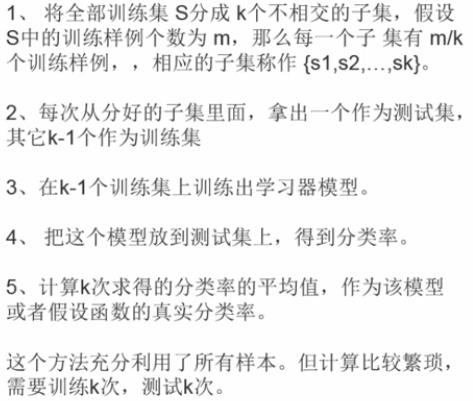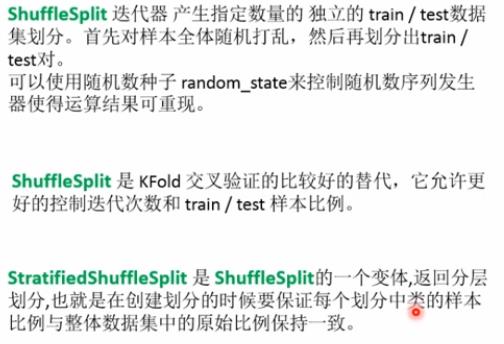『Sklearn』数据划分方法
Posted 叠加态的猫
tags:
篇首语:本文由小常识网(cha138.com)小编为大家整理,主要介绍了『Sklearn』数据划分方法相关的知识,希望对你有一定的参考价值。
原理介绍
K折交叉验证:
KFold,GroupKFold,StratifiedKFold,

留一法:
LeaveOneGroupOut,LeavePGroupsOut,LeaveOneOut,LeavePOut,

随机划分法:
ShuffleSplit,GroupShuffleSplit,StratifiedShuffleSplit,

代码实现
流程:
实例化分类器 -> 迭代器迭代组[.split()]
KFold(n_splits=2)
#KFold
import numpy as np
from sklearn.model_selection import KFold
X=np.array([[1,2],[3,4],[5,6],[7,8],[9,10],[11,12]])
y=np.array([1,2,3,4,5,6])
kf=KFold(n_splits=2) # 定义分成几个组
# kf.get_n_splits(X) # 查询分成几个组
print(kf)
for train_index,test_index in kf.split(X):
print("Train Index:",train_index,",Test Index:",test_index)
X_train,X_test=X[train_index],X[test_index]
y_train,y_test=y[train_index],y[test_index]
#print(X_train,X_test,y_train,y_test)
GroupKFold(n_splits=2)
# GroupKFold,不是很懂这个划分方法
import numpy as np
from sklearn.model_selection import GroupKFold
X=np.array([[1,2],[3,4],[5,6],[7,8],[9,10],[11,12]])
y=np.array([1,2,3,4,5,6])
groups=np.array([1,2,3,4,5,6])
group_kfold=GroupKFold(n_splits=2)
group_kfold.get_n_splits(X,y,groups)
print(group_kfold)
for train_index,test_index in group_kfold.split(X,y,groups):
print("Train Index:",train_index,",Test Index:",test_index)
X_train,X_test=X[train_index],X[test_index]
y_train,y_test=y[train_index],y[test_index]
#print(X_train,X_test,y_train,y_test)
#GroupKFold(n_splits=2)
#Train Index: [0 2 4] ,Test Index: [1 3 5]
#Train Index: [1 3 5] ,Test Index: [0 2 4]
StratifiedKFold(n_splits=3)
# stratifiedKFold:保证训练集中每一类的比例是相同的(尽量)
import numpy as np
from sklearn.model_selection import StratifiedKFold
X=np.array([[1,2],[3,4],[5,6],[7,8],[9,10],[11,12]])
y=np.array([1,1,1,2,2,2])
skf=StratifiedKFold(n_splits=3)
skf.get_n_splits(X,y)
print(skf)
for train_index,test_index in skf.split(X,y):
print("Train Index:",train_index,",Test Index:",test_index)
X_train,X_test=X[train_index],X[test_index]
y_train,y_test=y[train_index],y[test_index]
#print(X_train,X_test,y_train,y_test)
#StratifiedKFold(n_splits=3, random_state=None, shuffle=False)
#Train Index: [1 2 4 5] ,Test Index: [0 3]
#Train Index: [0 2 3 5] ,Test Index: [1 4]
LeaveOneOut()
# leaveOneOut:测试集就留下一个
import numpy as np
from sklearn.model_selection import LeaveOneOut
X=np.array([[1,2],[3,4],[5,6],[7,8],[9,10],[11,12]])
y=np.array([1,2,3,4,5,6])
loo=LeaveOneOut()
loo.get_n_splits(X)
print(loo)
for train_index,test_index in loo.split(X,y):
print("Train Index:",train_index,",Test Index:",test_index)
X_train,X_test=X[train_index],X[test_index]
y_train,y_test=y[train_index],y[test_index]
#print(X_train,X_test,y_train,y_test)
#LeaveOneOut()
#Train Index: [1 2 3 4 5] ,Test Index: [0]
#Train Index: [0 2 3 4 5] ,Test Index: [1]
#Train Index: [0 1 3 4 5] ,Test Index: [2]
#Train Index: [0 1 2 4 5] ,Test Index: [3]
#Train Index: [0 1 2 3 5] ,Test Index: [4]
#Train Index: [0 1 2 3 4] ,Test Index: [5]
LeavePOut(p=3)
LeavePOut:测试集留下P个
import numpy as np
from sklearn.model_selection import LeavePOut
X=np.array([[1,2],[3,4],[5,6],[7,8],[9,10],[11,12]])
y=np.array([1,2,3,4,5,6])
lpo=LeavePOut(p=3)
lpo.get_n_splits(X)
print(lpo)
for train_index,test_index in lpo.split(X,y):
print("Train Index:",train_index,",Test Index:",test_index)
X_train,X_test=X[train_index],X[test_index]
y_train,y_test=y[train_index],y[test_index]
#print(X_train,X_test,y_train,y_test)
#LeavePOut(p=3)
#Train Index: [3 4 5] ,Test Index: [0 1 2]
#Train Index: [2 4 5] ,Test Index: [0 1 3]
#Train Index: [2 3 5] ,Test Index: [0 1 4]
#Train Index: [2 3 4] ,Test Index: [0 1 5]
#Train Index: [1 4 5] ,Test Index: [0 2 3]
#Train Index: [1 3 5] ,Test Index: [0 2 4]
#Train Index: [1 3 4] ,Test Index: [0 2 5]
#Train Index: [1 2 5] ,Test Index: [0 3 4]
#Train Index: [1 2 4] ,Test Index: [0 3 5]
#Train Index: [1 2 3] ,Test Index: [0 4 5]
#Train Index: [0 4 5] ,Test Index: [1 2 3]
#Train Index: [0 3 5] ,Test Index: [1 2 4]
#Train Index: [0 3 4] ,Test Index: [1 2 5]
#Train Index: [0 2 5] ,Test Index: [1 3 4]
#Train Index: [0 2 4] ,Test Index: [1 3 5]
#Train Index: [0 2 3] ,Test Index: [1 4 5]
#Train Index: [0 1 5] ,Test Index: [2 3 4]
#Train Index: [0 1 4] ,Test Index: [2 3 5]
#Train Index: [0 1 3] ,Test Index: [2 4 5]
#Train Index: [0 1 2] ,Test Index: [3 4 5]
ShuffleSplit(n_splits=3,test_size=.25,random_state=0)
# ShuffleSplit 把数据集打乱顺序,然后划分测试集和训练集,训练集额和测试集的比例随机选定,
# 训练集和测试集的比例的和可以小于1
import numpy as np
from sklearn.model_selection import ShuffleSplit
X=np.array([[1,2],[3,4],[5,6],[7,8],[9,10],[11,12]])
y=np.array([1,2,3,4,5,6])
rs=ShuffleSplit(n_splits=3,test_size=.25,random_state=0)
rs.get_n_splits(X)
print(rs)
for train_index,test_index in rs.split(X,y):
print("Train Index:",train_index,",Test Index:",test_index)
X_train,X_test=X[train_index],X[test_index]
y_train,y_test=y[train_index],y[test_index]
#print(X_train,X_test,y_train,y_test)
print("==============================")
rs=ShuffleSplit(n_splits=3,train_size=.5,test_size=.25,random_state=0)
rs.get_n_splits(X)
print(rs)
for train_index,test_index in rs.split(X,y):
print("Train Index:",train_index,",Test Index:",test_index)
#ShuffleSplit(n_splits=3, random_state=0, test_size=0.25, train_size=None)
#Train Index: [1 3 0 4] ,Test Index: [5 2]
#Train Index: [4 0 2 5] ,Test Index: [1 3]
#Train Index: [1 2 4 0] ,Test Index: [3 5]
#==============================
#ShuffleSplit(n_splits=3, random_state=0, test_size=0.25, train_size=0.5)
#Train Index: [1 3 0] ,Test Index: [5 2]
#Train Index: [4 0 2] ,Test Index: [1 3]
#Train Index: [1 2 4] ,Test Index: [3 5]
StratifiedShuffleSplit(n_splits=3,test_size=.5,random_state=0)
# StratifiedShuffleSplitShuffleSplit 把数据集打乱顺序,然后划分测试集和训练集,
# 训练集额和测试集的比例随机选定,训练集和测试集的比例的和可以小于1,但是还要保证训练集中各类所占的比例是一样的
import numpy as np
from sklearn.model_selection import StratifiedShuffleSplit
X=np.array([[1,2],[3,4],[5,6],[7,8],[9,10],[11,12]])
y=np.array([1,2,1,2,1,2])
sss=StratifiedShuffleSplit(n_splits=3,test_size=.5,random_state=0)
sss.get_n_splits(X,y)
print(sss)
for train_index,test_index in sss.split(X,y):
print("Train Index:",train_index,",Test Index:",test_index)
X_train,X_test=X[train_index],X[test_index]
y_train,y_test=y[train_index],y[test_index]
#print(X_train,X_test,y_train,y_test)
#StratifiedShuffleSplit(n_splits=3, random_state=0, test_size=0.5,train_size=None)
#Train Index: [5 4 1] ,Test Index: [3 2 0]
#Train Index: [5 2 3] ,Test Index: [0 4 1]
#Train Index: [5 0 4] ,Test Index: [3 1 2]
以上是关于『Sklearn』数据划分方法的主要内容,如果未能解决你的问题,请参考以下文章